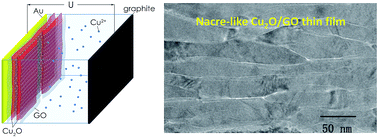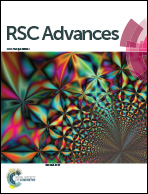Mechanical enhancement of a nanoconfined-electrodeposited nacre-like Cu2O layered crystal/graphene oxide nanosheet composite thin film†
Abstract
Graphene oxide (GO) based two dimensional (2D) nanosheets show great advantages for constructing nacre-like composites. Among the existing nacre structures, GO sheets were mostly used as hard inorganic components as those in nacre to improve the mechanical properties. Here, a novel nanoconfined electrodeposition process was explored to fabricate nacre-like Cu2O/graphene oxide (GO) thin films, where GO nanosheets functioned as the soft organic components in nacre. The inter-layer spaces between the GO nanosheets were used as templates for the growth of single crystalline Cu2O nanolayers, with thicknesses of several to tens of nanometers, though Cu2O belongs to the cubic phase. Due to the small lattice mismatch between the (1![[1 with combining macron]](https://www.rsc.org/images/entities/char_0031_0304.gif) 0) plane of Cu2O and the (001) plane of GO, the Cu2O nanolayers most likely grew on the (001) plane of GO. The resulting nacre-like thin film demonstrates a 6 times greater hardness and a 3 times greater Young’s modulus, than those of pure GO thin films. This technique provides a promising route for the synthesis of nacre-like metal (metal-oxide)/GO composites.
0) plane of Cu2O and the (001) plane of GO, the Cu2O nanolayers most likely grew on the (001) plane of GO. The resulting nacre-like thin film demonstrates a 6 times greater hardness and a 3 times greater Young’s modulus, than those of pure GO thin films. This technique provides a promising route for the synthesis of nacre-like metal (metal-oxide)/GO composites.



 Please wait while we load your content...
Please wait while we load your content...